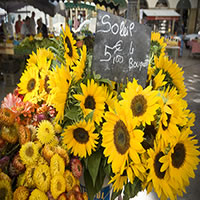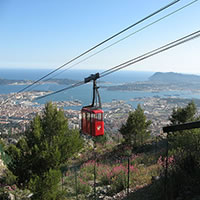PROVENCE - THE PROVENCAL COAST - ATTRACTIONS

Beaches
The Mediterranean coast contains some of the most beautiful beaches in the world. Because there are so many great beaches in this region, it is impossible to list all of them, but here is a list of a few of some of our favorites in this region:
Plage de l`Almanarre in Hyeres - The beach runs from the coast to a peninsula town called Giens. This beach is particularly well-liked among windsurfers and kite surfers. There is a marsh area just behind the beach where you can spot the region`s famous wild pink flamingos.
Close to the town of Cassis, there`s a beach in the calanques called L`lle de Riou, which is only accessible by boat. The small beach is a fantastic starting point for snorkelers and scuba divers, as the whole area of the calanques is full of underwater wonders.
Bandol Beaches are mostly sandy beaches, the ones to the east of the center include Plage Centrale, Plage du Casino and Plage du Grand Vallat while the small rocky beaches are to the west - some favorites include the Plage Eden Roc, Plage L`Anglais and the Plage des Engraviers.
Located west of Sanary sur Mer are the beaches of Lido, Gourgette and Beaucours, while Portissol and the beach of the Esplanade are most centrally located, and Bonnegrace beach is located to the south-east. There are also many other small beaches around this area as well.

Calanques
A calanque is a natural inlet surrounded by steep rocky promontories jutting out into the sea with beautiful rugged cliffs and creeks. Created by natural events and shaped by wind, sea and rain over the last 120 million years, the calanques of Cassis stretch from Marseille to Cassis. This is one of France`s most beautiful natural areas. The calanques can be enjoyed from a small boat on the sea, with many different boat trips available out of the Cassis port. As well as being a scenic attraction there are also several small beaches set among the rocks, with pine trees climbing the hill behind the beaches, offering absolute beautiful settings for a swim between the cliffs. The calanques are also a popular area for hikers and divers.
The famous three Cassis Calanques: Calanque de Port Miou, Calanque de Port Pin and Calanque d`En-Vau, which all can be accessed from Cassis.
In September 2016 the calanques between Marseille and Cassis were laid waste by a terrible forest fire. It destroyed 8,650 acres of land and had a severe impact on the fragile ecosystem of the region. It will take many years for the land to recover.

Iles d`Hyeres
The Iles d`Hyeres (The Hyeres Islands) are a group of islands in the Mediterranean just off the southern coast of France near the mainland town of Hyeres. The islands are Porquerolles, Le Lavant and Port-Cros. These three islands together form a rare and gorgeous environment with large stretches of beaches, sea and nature. The islands are commonly reached by boats departing from either Toulon, Hyeres, Le Lavandou, Cavalairesur Mer and La Croix Valmer. The shortest route is from the Giens peninsula south of Hyeres, about a 15-20 minute boat ride. The islands are also known for its amazing scuba diving especially around Palud beach - there is even a popular `underwater trail` to follow starting from this beach.
Porquerolles is the easiest island to access and includes a village (also called Porquerolles) and an ancient fort. It is a small island, only 4.3 miles by 1.8 miles; many visitors choose to explore the island by bike. Porquerolles has outstanding beaches and rugged shorelines making it a beautiful place to discover. The southern coast of the island is more rugged with high cliffs so most visitors travel north for beaches, but you can still explore here through small trails that lead to isolated coves.
Port Cros is a designated French National Park (the National Park of Port-Cros) and the most rugged and unspoiled of the three islands. The island is stunning to explore the marked paths. There is a lovely port with palm trees along the promenade.
Le Lavant is the least accessible due to most of the island being used for military. There is a number of trails located on the west of the island that are beautiful to explore. There is also a local naturist center called Héliopolison Le Levant, and there are regions of the island where naturism is required.

Markets of the Provencal Coast
Every town on the Provencal Coast has at least one weekly market; some occur twice a week or even daily. You can easily spend a day wandering through the stalls taking in the lively ambiance and discovering the many fresh Provencal goods such as fruits and veggies, cured meats, olives, a wide variety of cheeses, olive oil, jam, honey, soap, lavender, colorful cloths, prepared foods, wine, kitchen items, dried herbs, art, pottery, and more.

Mont Faron
Mont Faron, a landmark of Toulon, is an impressive mountain overlooking the city offering amazing panoramic views of the Mediterranean Sea. The top can be reached by foot, car, or cable car. It is possible to take a slow-paced walk or a more vigorous hike along the foot paths to the summit. The cable car, the only one of its kind on the Mediterranean coast, offers the most spectacular transfer to the top of Mont Faron. The ride offers spectacular views as it climbs to the top reaching 4,714 ft. Near the summit there is a zoo which covers an area of 3.7 acres.

Presqu`ile de Giens (The Giens Peninsula)
The Giens peninsula boasts magnificent beaches, small fishing villages, an extensive nature reserve and beautiful coastal walks. It is also an unusual geographical site, one of the small numbers of peninsulas joined to the mainland with two branches instead of the usual one.
There are beaches along the east side of the peninsula and a longer beach, the Plage d`Almanarre along the west coast. You can also find a few smaller beaches along the southern coast. The southern part of the peninsula is where most of the traditional small ports and fishing villages are located, including the Port de la Tour Fondue, Port Auguier, the Port du Neil (the most picturesque) and Port de la Madrague as well as the town of Giens. The center of the peninsula is only accessible by guided walks available seasonally.

Roman Ruins at Olbia
Olbia is an ancient colony belonging to the major trading point of Marseille. This settlement was founded in the year 325 BC. In the ancient Greek language, the word `Olbia` means `The Blessed One,` which suggests the important economic role that this settlement played in its time.The settlement survived the fall of the Western Roman Empire and lasted the first two centuries of the Middle Ages. The archaeological site of Olbia is the only one on the Mediterranean coast to have been preserved in its entirety. Since the mid 19th-century, archaeological excavations have unearthed remnants of private dwellings, sanctuaries, paved streets, public baths, and more.
The archaeological site is opened to the public and may be visited independently or with a guide who will tell you about the way Olbians used to live under the protection of their gods. The excavations have also revealed how the city used to be sub-divided in neighborhoods, revealing much about the way its first inhabitants` - fishermen, ceramists, soldiers - way of life.

Route des Cretes, Provence
The coast road of Route des Cretes is located between Cassis and La Ciotat, southeast of Marseille. This is one of the most scenic coastal roads in France and although it is not very long, a visit is greatly recommended when you are in the Provencal coast area.
The Routes des Cretes follows along the cliffs in the region. The D141 road along the cliffs is about 9 miles long and at its highest point, the altitude reaches 1,290 feet. The cliffs here are the highest in France and among the highest in Europe. The main part of the cliffs is between Cap Canaille and the Bec de l`Aigle. There are many places along the route to stop and take in the magnificent views or walk along the footpaths that follow the cliffs to have more views. The entire route takes about one hour depending on the number of stops you take.
Note: There are several other routes called `route des cretes` in France, including one on the northern rim of the Gorges du Verdon and another in the Vosges region. The specific Routes des Cretes in Provence that we are referring to is located on the coast in the Bouches du Rhone department.

Towns and Villages
One of the most popular of the attractions on the Provencal Coast is the towns and villages themselves. Wander through the sun-soaked, ancient streets of the city centers and discover the different treasures each town and village has to offer. Many of these towns date back thousands of years and each offers a subtly different variation on the same theme. Take notice of the individual character from quirky doorways, to beautiful shop facades and colorful flowers - a quintessential southern France experience.
Some towns and villages on the Provencal Coast include Bandol, Cassis, Hyeres, La Cadiere d`Azur, La Ciotat, La Seyne Sur Mer, Le Pradet, Saint Cyr Sur Mer, Sanary Sur Mer, Six Fours les Plages, and Toulon.

Wines of Bandol and Cassis
The vineyards that you will see around the town of Bandol provide the grapes to produce one of the most celebrated wines in France. The strong reds and rosés are the best known of the Bandol wines but white wines are also produced here. The wine of Bandol receives a high reputation due to the use of the Mourvèdre grape which grows around the town but very few other places in France: it is said to be difficult to grow and demands very specific conditions of soil and sunshine.
Wine in Cassis is the city`s second most important industry after tourism. The wines here was one of the first three places to receive the appellation d`origine controlee (label of controlled origin), which was introduced in 1936. There are extensive tours of the village`s wineries through the Provence Wine Route. The wines of Cassis are known for its full-bodied, herb scented white wines, and a vast majority of the wine here never leaves the region, making it a good reason to visit.